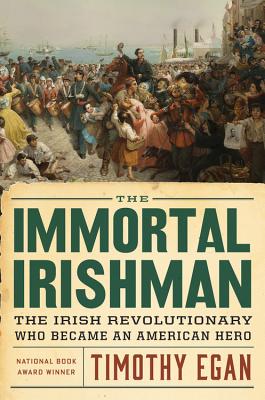The Immortal Irishman
Timothy Egan’s The Immortal Irishman: The Irish Revolutionary Who Became an American Hero (2016) tells the life story of Thomas Francis Meagher (pronounced Mar). Egan’s work is a biography albeit one brimming over with adventure. Starting with Meagher’s final days, as the first governor of Montana territory, Egan takes his reader back to the Irishman’s early days in Waterford, Ireland. Meagher’s story circumnavigates the globe and abounds with plenty of larger-than-life details. If the biography weren’t rooted in so much fact, most readers would find all the lives Thomas Meagher lived beyond belief.
Meagher was the darling son of a moneyed merchant family, born in Waterford, Ireland in 1823. Egan describes Waterford eloquently as he sets Meagher’s life in its context of complicated Irish-British history. After studying at an elite school for boys in England, young Meagher returned to Ireland eager to join the ranks who called for Irish liberation or, at the very least, a larger degree of representation for Ireland’s predominately Catholic population. Through poetry and spoken words, nineteenth-century Ireland found a voice. In this milieu, Thomas Meagher found a calling as one of Ireland’s young orators. But like so many heroes of the Irish, Meagher did not end up liberating anyone; his story leads to forced exile and life in the penal colonies of Australia.
Meagher’s story winds through Irish poets and liberation politicians to the penal colonies of Australia, and finally to life in the United States. Meagher ends up in New York City in the years leading up to the Civil War. While wooing some of Manhattan’s elite, Meagher ultimately led the famous Irish Brigade from New York for the Union. Through the brazen courage of his Irish Brigade, General Meagher made a name for himself and his fighting Irish.
In the years after the Civil War, Meagher heads for the wilds of the newly-named Montana Territory. It is here his story ends. The Irish revolutionary, penal colony prisoner and Civil War General meets his end in the Wild West. Meagher’s biography is so diverse that Egan’s book includes details about many nineteenth-century realities: the plight of the Irish, the British penal colonies, Irish immigrants in the US, the Civil War, and young Montana Territory, vigilantes and all. Egan’s writing is smooth and detailed; he brings Meagher’s striking personae to life time and time again.
I learned a great deal from Egan’s Immortal Irishman, while also thoroughly enjoying the prose. The Immortal Irishman is an excellent read, and certainly not a dull historical biography. Meagher’s story is both exciting and compelling as it meanders through nineteenth-century Irish and American history. I encourage anyone with an interest in nineteenth-century history (be it Irish, British, Australian, or American), a connection with Montana, or a fascination with the stirring life of one man, to pick up a copy of The Immortal Irishman.
Bibliography:
Egan, Timothy. The Immortal Irishman: The Irish Revolutionary Who Became an American Hero. Houghton Mifflin Harcourt: New York, 2016.







